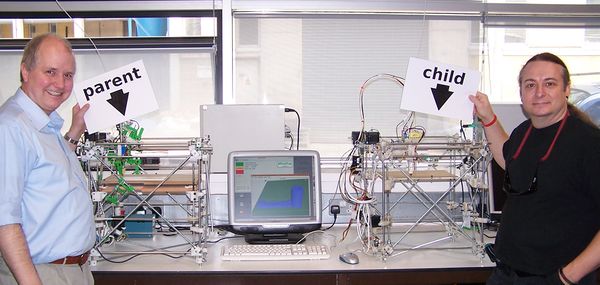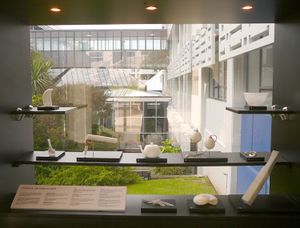About/hu
|
English • العربية • български • català • čeština • Deutsch • Ελληνικά • español • فارسی • français • hrvatski • magyar • italiano • română • 日本語 • 한국어 • lietuvių • Nederlands • norsk • polski • português • русский • Türkçe • українська • 中文(中国大陆) • 中文(台灣) • עברית • azərbaycanca • |
Contents
A koncepció
Nézd meg a kompod és képzelj mellé egy 3D-s nyomtatót. Kis papírdarabkák helyett ez a nyomtató valódi, erős, mechanikai alkatrészeket állítana elő. Gondolj a Lego építőkockáira és máris elképzelheted hogyan készíthetsz használható tárgyakat. Előállíthatsz hasznos tárgyakat vagy kinyomtathatod egy másik 3D-s nyomtató alkatrészeit. Ez egy gép lenne, ami lemásolhatja saját magát.
A megvalósítás
<videoflash type="vimeo" width="400" height="320">5202148</videoflash>
Adrian Bowyer találta ki a RepRap-et és az ötlet először 2004 februárjában vált a neten is elérhetővé.
A RepRap egy rövidítése a gyors-prototípus másosolásnak (Replicating Rapid-prototyper). A bal oldali videón egy önreprodukáló gép látható működés közben. Ez a 3D-s nyomtató a műanyag alkatrészeket műanyag rétegekből építi fel. Ez a technológia már létezik, de a legolcsóbb kereskedelmi gép ára kb. €30,000. És ez nem képes reprodukálni saját magát. A RepRap csapat egy olyan gép fejlesztésén dolgozik, ami sokkal olcsóbb és képes reprodukálni saját magát (az anyagköltség kb. €350). A 3D-s nyomtatás elérhető kis közösségeknek a fejlődő világban és magányszemélyeknek a fejlett világban. A RepRap-et bárki számára elérhetővé tettük a Szabad Szoftver Mozgalom nyílt forrású liszenszével (GPL). Tehát, ha van egy RepRap géped, akkor készíthetsz egy másikat, amit megoszthatsz egy barátoddal...
A RepRap projekt 2005 márciusában kapott nagy sajtónyilvánosságot és ezzel vált ismertté, bár az ötlet 2004 február 2-áig nyúlik vissza, amit Adrian Bowyer publikált a weben először.
Machine Self-Replication
Not counting nuts and bolts RepRap can make 50% of its parts; the other parts are designed to be cheaply available everywhere. The primary goal of the RepRap project is to create and to give away a makes-useful-stuff machine that, among other things, allows its owner cheaply and easily to make another such machine for someone else.
To increase that 50%, the next version of RepRap will be able to make its own electric circuitry - a technology we have already proved experimentally - though not its electronic chips. After that we'll look to doing transistors with it, and so on...

Scholarship
Academics and others seeking refereed journal articles on RepRap may care to start with this paper in Robotica. The citation and link are:
Jones, R., Haufe, P., Sells, E., Iravani, P., Olliver, V., Palmer, C., and Bowyer, A.,: RepRap – the replicating rapid prototyper, Robotica (2011) volume 29, pp. 177–191. Cambridge University Press.
If you are interested in the legal aspects of this technology, then you may care to read this paper:
Bradshaw, S., Bowyer, A. and Haufe, P.: The Intellectual Property Implications Of Low-Cost 3D Printing, ScriptEd, April 2010 pp.5-31.
There is also a study on the spread of RepRap and its population:
Erik de Bruijn: On the viability of the open source development model for the design of physical objects, November 8th 2010, University of Tilburg, The Netherlands.
Glossary
- RepRap - n. any free rapid prototyping machine that can manufacture a significant fraction of its own parts; v.t. (in lower case: to reprap) to make something in a RepRap machine.
- RepStrap - n. any free rapid prototyping machine that doesn't make its own parts, but is intended to make parts for a RepRap.
- reprapper - n. a person engaged in making or using RepRaps or RepStraps.
- reprapable - adj. capable of being made in a RepRap machine.
